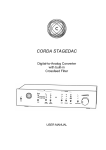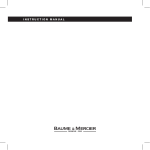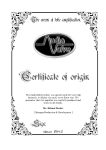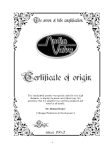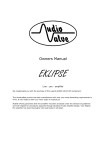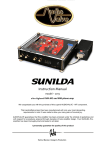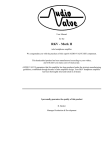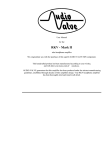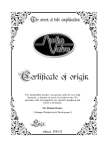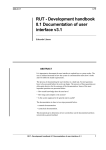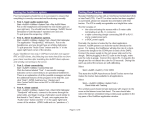Download Audiovalve CORDA EARTUBE-1 User manual
Transcript
EARTUBE USER MANUAL Dear music-lover, The CORDA EARTUBE-1 is a small-power amplifier, specially designed to drive headphones. It offers a sound quality and driving capabilities far beyond that of an ordinary headphone socket found on a CD-player or amplifier and thus allows you to exploit the full sonic potential of your phones. Due to the close contact to your ears, headphones provide an extreme channel separation whilst listening to stereo recordings. Unlike loudspeakers, none of the sonic information in the left channel is acoustically transferred to the right ear and vice versa. Although this adds to the extreme high level of detail that can be achieved with headphones, it subconsciously also introduces mental stress. The natural correlation of stereo sound interpreted by the brain is lost. The CORDA EARTUBE-1 not only offers normal stereo reproduction of your music, but it also has a facility to add some of the left channel information to that of the right channel and vice versa. Thus mental stress is reduced and music can be enjoyed with more ease. By design only tubes are found inside the signal path of the amp. Solid state electronics are only used to create a stable voltage supply. For safety and in order to obtain the best possible results with your new headphone preamplifier, we ask you to read these instructions carefully. The EARTUBE-1 was developed by music-lovers for music-lovers and we hope that it will serve you well for a long time. Helmut Becker Safety precautions Children and minors are not to use the device and should be kept at a safe distance from the device while it is running. Do not run the device without the top cover in place. Voltages inside the amp can be lethal and temperatures are high. Please check that the mains voltage printed on the bottom panel of the amplifier corresponds with the mains voltage in the country where you intend to use the amplifier. Disconnect the powercord before any service to the amplifier. In the unlikely event of a failure of the device repairs may be performed by authorized technicians only. Use ORIGINAL spare parts only! Please take note of the fact that we decline product liability for damages caused by our devices, parts and components as a result of: Unprofessional and/or faulty and/or incorrect repairs that have been performed in other than the approved repair facilities. Usage of other than ORIGINAL and approved spare parts. All devices must be operated under moderate climatological circumstances, comparable to those under which human beings usually live. When the surrounding temperature is too high, the device will heat up beyond its optimal parameters. This can damage the amplifier. Proper ventilation is needed, and the amplifier should not be covered in. Allow approximately 3 cm of air sidewise and approximately 4 cm above the amplifier to cool the amplifier. Once the amplifier has arrived at its desired destination, make sure the amplifier has ample time to adjust to the climate at its new location. It is likely that the changes in temperature and humidity between the last location and the new one, has caused condensation to build up somewhere in the amplifier. This can damage the device. Please allow the amplifier at least two hours to acclimatise. The amplifier comes fully assembled, ready to go. The decive MUST be switched OFF while connecting it to other components. A softstart prevents high initial currents through the cold, low impedance, heating element. This prevents the element to break at its most narrow spot. Connections At the rear side of the CORDA EARTUBE-1 two pairs of inputs allow you to connect two different audio sources that have typical output voltages above 0.1 Volts (CD-player, cassette-player, tuner, minidisc-player, ...). The source you want to listen to can be selected by the switch at the left front side of the amp. If your audio system already contains a central preamplifier or integrated amplifier you may prefer to connect the EARTUBE-1 to the tape-out of your central amplifier. The source now can be selected by the Rec-switch of this central amp. Your headphone should be connected to one of the headphone-sockets on the front side of the EARTUBE-1. You can also use the sockets to connect two headphones simultaneously. The sockets are intended for 6.35 mm stereo jacks. If your headphone only has a 3.5 mm jack, then use an adapter that can be obtained in most electronics or audio shops. Activation of the device Before connection of the CORDA EARTUBE-1 to the mains, please check the voltage required. The proper value can be found on the bottom-side of your device. After connection the EARTUBE-1 can be switched ON/OFF by the power switch. While switched ON the LED on the front side will be lit. It takes around 10 seconds before the amp is fully activated. We recommend to power the amplifier ON approximately 15 minutes before use. If the device is not used for a longer period of time it should be switched OFF. Not only does this reduce energy consumption but it also increases life-time of the tubes. Volume control The volume of the CORDA EARTUBE-1 is controlled by the large dial on the left side of the front panel and is increased by clock-wise rotation. The driving capabilities of the CORDA EARTUBE-1 by far exceed that of a regular CD-player. This not only guarantees less distortion, but also has the danger of severe hearing damage. While listening to headphones we lack several feedback mechanisms on volume level that are present when we listen to loudspeakers. Much less distortion, no feeling of the lower frequencies by our body and no psychological restraints not to annoy our fellow-men easily seduces us to listen at volume levels that are detrimental to our hearing. Hearing damage from regular exposure to high sound levels progresses slowly but is irreversible and can result in permanent hearing loss. !! Please choose your volume-setting with caution !! Directional listening In normal daily life people use various mechanisms to locate sources of sound. Firstly, the sound of a source to the right side of the listener (e.g. the right loudspeaker) not only reaches the right ear but, attenuated and delayed, is also heard by the left ear. The level of attenuation and the delay time of this crossfeed signal provide important directional information. Secondly, the soundwaves are partly absorbed and partly reflected by the tissues of the head. Reflections at the oracles (pinnae) interfere with the soundwaves that directly enter the ear-channel and amplify or attenuate specific frequency components. Since these reflections depend on the direction of the soundwave the “color” of the sound changes with the direction of the source. Thirdly, reflections of the soundwaves from the walls, ceiling and floor of our listening room produce reverberation that conveys an extra feeling of space. The information obtained by these mechanisms is further refined by movements of the head. Changes in sound levels, delay times and sound color refine the sense of direction. For a demonstration, blindfold a friend and ask him to locate a ticking clock that you have hidden in the room. He will start turning his head although he can’t see anything. With his head in a fixed position an exact localization is much more difficult. Listening by headphones All these mechanisms are missing when we listen to music by headphones. The sound at the right ear will no longer reach the left ear and pinnae-reflections no longer interfere with the original soundwave. Moreover, the headphones are directly attached to our head, and so head movements no longer add information. Reverberation is also not present. As a result, the sound heard by headphones seems to stick to the inside of our head and to our ears and an unnatural soundfield is created. The brain misses logical clues for direction and this subconsciously results in mental stress. Some people cannot tolerate this stress and are unable to use headphones. The natural crossfeed filter In principle, digital soundprocessors can simulate all the mechanisms for directional listening but the results are, thus far, not very satisfactory. In particular, pinnae-reflections are very complex and listener-specific and impossible to simulate accurately. Fortunately, the main directional information is provided by the time delay and level of attenuation of the sounds that reaches the opposite ear. The CORDA EARTUBE-1 can electronically simulate this process and, with appropriate attenuation and delay, add some of the right audiosignal to the left channel and vice -versa. This considerably reduces the adverse symptoms of headphone listening. A unique feature of the crossfeed circuitry of the EARTUBE-1 is that it “recognizes” the virtual positions of the instruments and singers in a recording. The sound of an instrument in the middle of the soundstage will be equally present in both audio-channels and isn’t given any crossfeed. A crossfeed signal is only generated for instruments that are not placed at the center. The more offcenter the instrument is placed, the stronger the crossfeed and the longer its delay. This feature is called “natural crossfeed”. Activation of crossfeed The crossfeed filter can be activated by the second left switch at the front of the amp. Lower position STEREO. In this position there is no crossfeed on the headphone outputs. We recommend this position for recordings with a narrow soundstage. Upper position LOW level crossfeed This setting is especially recommended for recordings with a relatively high level of reverberation (orchestra, choir) or extreme spatial positioning. Although the difference to the stereo position may not be discernable to you at first, after longer periods of listening you will find the crossfeed position much more relaxing. While activating the crossfeed the listener may notice an apparent lack of bass. In stereo mode, lower frequencies seem to be much more present. This is a psycho-acoustical effect and does not represent a limitation of the crossfeed filter. Lower frequencies heard by one ear only are much more unnatural to our brain than higher frequencies and therefore in stereo mode are more noticeable. Crossfeed integrates the lower frequencies in a more natural way into the soundstage which makes them less noticeable. Replacing tubes The EARTUBE-1 uses three tubes 6N3P and two tubes GU17 (or its equivalents QQE03/12, RS1023, 6360) If you want to exchange tubes, please disconnect the power cord before removal of the top cover. Also make sure that all pins are properly mounted into the sockets. It is not uncommon that a pin is bend and doesn't enter the socket. Do not run the device without the top cover in place! Technical data Measures: 28 x 30 x 11 cm Weight: 6.0 kg Power supply: US-Version: European Version: Maximal amplification (1 kHz): 16 dB at 200 Ohm Maximum output: 35 Volts at 200 Ohm Input impedance: 47 kOhm Output impedance: 20 Ohm 100/120 Volts, 50/60 Hz 200/240 Volts, 50/60 Hz CE – Confirmity Declaration Of Conformity Manufacturer: AudioValve, Germany, 34123 KASSEL, Umbachsweg 70, [email protected] Product Name: ASSISTENT 100 Product Type: Audio Amplifier Complies with Standards: LVD: 92/31/EEC, 93/68/EEC, & 73/23/EWG Safety: EN60065 EMC: EN55013, EN55020, EN55022, EN55103, EN61000-3-2, & EN61000-3-3 The official Declaration of Conformity for this product is kept on file at: AudioValve, 34123 Kassel,Umbachsweg 70, Tel. 05617013360 WARRANTY AUDIOVALVE warrants its components for a two - year period on all electronics and a 90day period on the tubes from the purchase date. In the event of a failure of your amplifier , AUDIOVALVE will repair or readjust this unit or , should the occasion arise , will replace it provided that all conditions stipulated in this warranty are met. In order to initiate service of any kind it is necessary to obtain distributor or dealer authorization prior to shipping the unit for service. Any of the following conditions shall void the warranty: • Operation not in accordance with this manual. • Abuse , accidental damage or unauthorized modifications , as determined by AUDIOVALVE or its agents exclusively. • Removal , defacing or falsifying of the serial numbers. • Shipping without the original complete factory crates. WARRANTY REGISTRATION Please fill out and return this warranty form to the distributor within 15 days of the purchase date with this form here, or make it online on our webside. • MODEL : _______________________________________________ • SERIAL NUMBER : _______________________________________ • PURCHASE DATE : ______________________________________ • AUTHORIZED AUDIOVALVE DEALER: • PURCHASER`S NAME : ___________________________________ • STREET ADDRESS : ______________________________________ • CITY : __________________________________________________ ZIP / POSTAL CODE : _____________________________________











